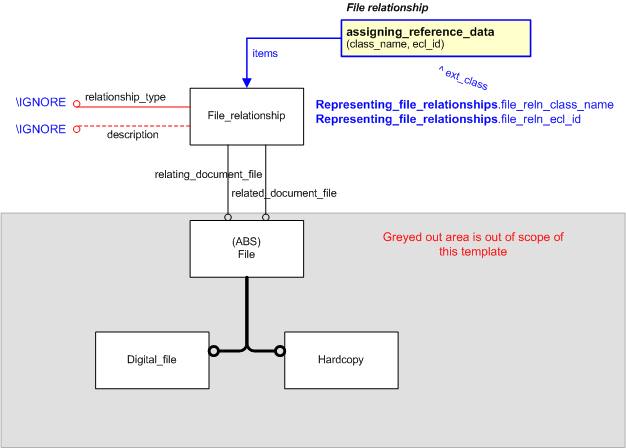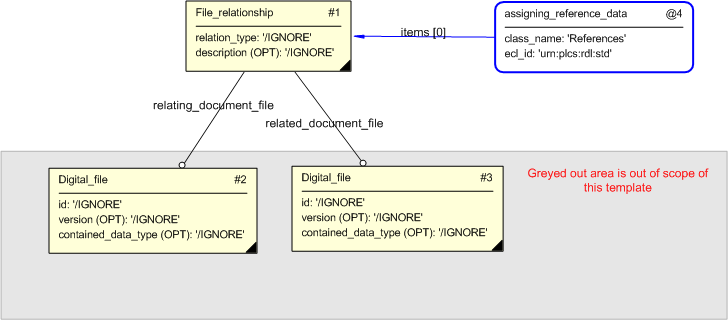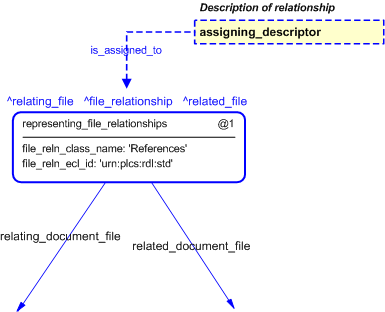Template:— representing_file_relationships (rep_file_relns)
Capability:representing_documents |
Date: 2009/03/18 11:48:48
Revision: 1.6
|
This section specifies the template representing_file_relationships.
NOTE
The template has been defined in the context of the capability
representing_documents
which provides an overall description of the
relevant parts of the ISO 10303-239 information model and a description
of related templates.
NOTE
An explanation of a template and the associated instantiation path is
provided in the
Template overview
section.
This template describes how to represent a relationship between two Files. The File(s) related can be either Digital_file(s),
Hardcopy files, or one of each. The "relating" and "related" File(s) must be different instances.
The EXPRESS-G diagram in
Figure
1
shows the templates and EXPRESS entities that are required
to represent the template
"representing_file_relationships".
The text highlighted in blue shows the template parameters.
Figure 1 — An EXPRESS-G representation of the Information model for representing_file_relationships
The graphic for the template to be used in other EXPRESS-G diagrams
is shown in Figure
2
below.
Figure 2 — The graphical representation of the representing_file_relationships template
The following input parameters are defined for this template:
The relating File - could be a Digital_file or Hardcopy instance
The relating File - could be a Digital_file or Hardcopy instance
The classification of the File_relationship entity.
The following classes and their sub-classes can be used:
classifications:
"File_relationship"
(urn:plcs:rdl:std:File_relationship),
[References]![[warning:]](../../../../images/dex/warning.gif) Error RDL1: The class References does not exist in RDL at urn urn:plcs:rdl:std. Check the dexlib/data/refdata/rdl_index.xml[Originates]
Error RDL1: The class References does not exist in RDL at urn urn:plcs:rdl:std. Check the dexlib/data/refdata/rdl_index.xml[Originates]![[warning:]](../../../../images/dex/warning.gif) Error RDL1: The class Originates does not exist in RDL at urn urn:plcs:rdl:std. Check the dexlib/data/refdata/rdl_index.xml[Derivation]
Error RDL1: The class Originates does not exist in RDL at urn urn:plcs:rdl:std. Check the dexlib/data/refdata/rdl_index.xml[Derivation]![[warning:]](../../../../images/dex/warning.gif) Error RDL1: The class Derivation does not exist in RDL at urn urn:plcs:rdl:std. Check the dexlib/data/refdata/rdl_index.xml
Error RDL1: The class Derivation does not exist in RDL at urn urn:plcs:rdl:std. Check the dexlib/data/refdata/rdl_index.xml
The identifier of the
External_class_library storing the
definition of the class used to classify the file identified.
The following reference parameters are defined for this template:
Allow the
File
entity instantiated in this path to be referenced when this template is used.
Note: The
File
entity can be referenced in a template path by:
%^target = $representing_file_relationships.relating_file%
where
target
is the parameter to which the
File
is bound.
Allow the
File
entity instantiated in this path to be referenced when this template is used.
Note: The
File
entity can be referenced in a template path by:
%^target = $representing_file_relationships.related_file%
where
target
is the parameter to which the
File
is bound.
The instantiation path shown below specifies the entities that are to be
instantiated by the template.
A description of templates and the syntax for the instantiation path is
provided in the
Templates Help/Information section.
The following entities are instantiated with attributes as specified:
The instance diagram in Figure
3
shows an example of the EXPRESS entities and templates that are instantiated by the template:
/representing_file_relationships(file_reln_class_name='References', file_reln_ecl_id='urn:plcs:rdl:std')/
(an illustration of the consolidated representing_file_relationships template is shown in
Figure
4 below.)
Figure 3 — Entities instantiated by representing_file_relationships template
The instance model in STEP ASCII exchange file format (ISO 10303 Part
21 syntax) is:
DATA;
#7 = EXTERNAL_CLASS_LIBRARY('urn:plcs:rdl:std',$);
#6 = EXTERNAL_CLASS('/IGNORE','References','/IGNORE',#7);
#5 = CLASSIFICATION_ASSIGNMENT(#6,(#1),'/IGNORE');
#3 = DIGITAL_FILE('/IGNORE','/IGNORE','/IGNORE');
#2 = DIGITAL_FILE('/IGNORE','/IGNORE','/IGNORE');
#1 = FILE_RELATIONSHIP('/IGNORE','/IGNORE',#2,#3);
ENDSEC;
The instance model in STEP XML exchange file format (ISO 10303 Part
28 ed.2 syntax) is:
The instance diagram in
Figure
4
shows the graphic symbol for the template that is to be
used in other instance diagrams. The example template is:
/representing_file_relationships(file_reln_class_name='References', file_reln_ecl_id='urn:plcs:rdl:std')/
Figure 4 — Entities instantiated by representing_file_relationships template
The following section details how the
representing_file_relationships
template can be optionally characterized by assigning
other constructs to it. These are characterizations commonly
applied to the template. The ISO 10303-239 EXPRESS model may enable
other assignments to the entities instantiated by the template.
The following characterizations may apply:
Characterization Assigning descriptor
NOTE this characterization is optional.
A description of the relationship can be provided using the template assigning_descriptor. This is applied to the ^relating_file or ^related_file reference parameters. See Figure 4 for the an abstract view of this.
The following template call shows how this might be instantiated.
/assigning_descriptor(descr='This relationship relates any constituent parts to a top level item', class_name='Description', ecl_id='urn:plcs:rdl:std', is_assigned_to='@1')/




